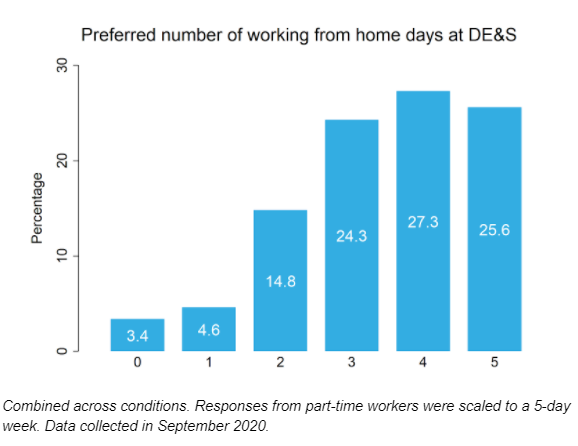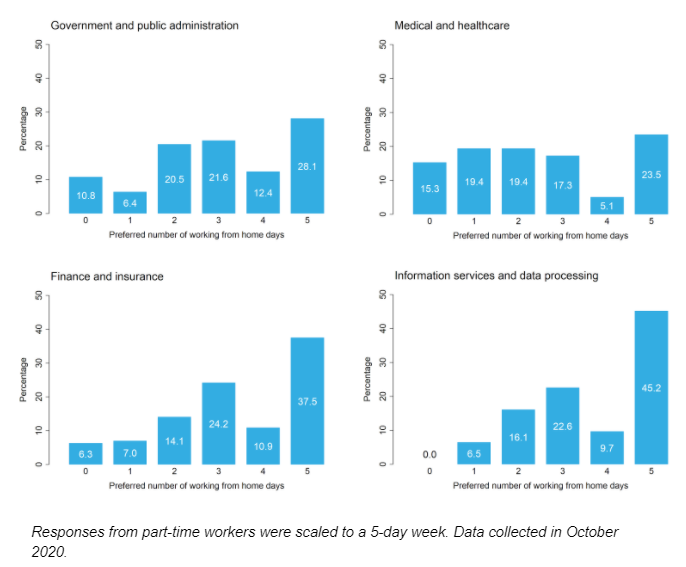Before the pandemic, only around 5% of UK employees worked entirely remotely. In the first lockdown this rose to 33% and 54% of UK employees are working remotely to some extent in April 2021.
Many affected organisations are now thinking about next steps for when the requirement to ‘work from home if possible’ is lifted. Thankfully, most have moved on from a binary all-or-nothing approach and towards a ‘hybrid’ approach of working some days at home and some onsite. Some companies, such as Facebook, Google and HSBC, have already announced a 3:2 (3 days onsite and 2 days from home) working arrangement, but are there any unforeseen impacts of this?
Testing the impact of remote working policies on equality
Today we launch a report detailing a randomised controlled trial (RCT) we ran with Defence Equipment & Support (DE&S). The trial set out to evaluate the impact of setting different expectations for how much employees should work from home. DE&S is a public sector organisation with 11,500 employees (66% men) and was heavily office-based prior to the pandemic.
In September 2020 we shared a survey with all DE&S staff that randomly showed them one of three messages:
- Control (no expectation set): Your responses will help us to plan reopening the offices.
- Default norm: We expect employees to continue to primarily work from home.
- Low anchor: We expect employees to work from home on average 2 days per week.
We asked employees about their intended and preferred number of working from home days when the office opens to more staff and their number of working days (to adjust for part-time responses). The response rate was 35% and we analysed completed surveys from 3,852 staff.
Download the report
Setting a specific expectation could create a gender gap
In the overall sample we found no differences in intended or preferred working from home days across the messages. However, when we looked at differences by gender, women reduced their intended working from home days by 8% in response to both messages that set an expected level, where men did not adjust at all.

Men and women had similar preferences for working from home, so the messaging created a gender gap in intentions and pushed women further away from their preferences. Women are more likely to have experienced ‘flexibility stigma’ and experience greater work-life conflict if fewer colleagues work from home, where men are less influenced by this. We think this result suggests that setting any kind of expectation could result in gender unequal uptake.
A one-size-fits-all approach fails most people
These findings demonstrate the potential danger of mandating a one-size-fits-all approach to the number of days employees should work from home. The reality is that behind these averages there is huge variation both within a single organisation and between industries. Selecting a set number of days per week is likely to only satisfy a minority of staff, even if it is the average preference.

In DE&S the average preferred number of working from home days was 3.5, but only 27% of staff specifically wanted to work from home 4 days a week. In fact, 77% of staff wanted to work from home 3, 4 or 5 days a week split fairly evenly across each number of days. There was no gender difference in preferences, but staff with a disability and with dependents wanted to work from home a significantly higher number of days.
Individual organisations will have different distributions of preferences to each other. In a forthcoming study where we surveyed over 4,000 UK employees throughout different stages of lockdown, we found preferences varied greatly by industry. Among those with access to remote work in their role, industry averages ranged from 1.3 to 4.2 preferred working from home days with an overall average of 3.2 days.

Download the report
True flexible working is about choice
So, what of the 3:2 split? Perhaps this was inspired by a study that found on average preferences for working from home in the US are around 2 days per week. While it’s understandable from a planning perspective, there will be fluctuations in demand. Failing to plan for fluctuations is planning to fail. As a result of these findings and a number of other factors, DE&S is looking to communicate a working from home policy “without imposing quotas” on time spent in the office vs. remotely.
By moving away from mandating one working arrangement, we can embrace the benefits of greater employee autonomy. Indeed there is an established literature demonstrating the relationship between autonomy and employee motivation, wellbeing and productivity. Two RCTs demonstrated that remote working increases productivity, and even more so when individuals have control over it.
Recommendations for employers
The appetite for remote working has greatly increased and with no difference between genders. Specifying a number of working from home days is likely only to satisfy a minority of staff and men may ignore it regardless, resulting in a gender gap. We encourage employers to allow employees to choose what works for them, while acknowledging and supporting the overall shift to increased remote working.
This work was undertaken in collaboration with DE&S. It is part of the Gender & Behavioural Insights Programme, which was funded by the Government Equalities Office.





